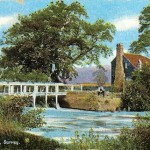- Stay Connected
 Abraham Lincoln
If given the truth, the people can be depended upon to meet any national crisis...
Abraham Lincoln
If given the truth, the people can be depended upon to meet any national crisis...
 Guildford news...
for Guildford people, brought to you by Guildford reporters - Guildford's own news service
Guildford news...
for Guildford people, brought to you by Guildford reporters - Guildford's own news service
Riff Raff Diary for November 2011
Published on: 1 Dec, 2011
Updated on: 29 Feb, 2012
Riff Raff Diary for December 2011
by Robert Craig
Riverbank tales from our local St Catherine’s Lengthsman/Weir-keeper
The first few days of November saw me busy operating the weirs after what has been a very quiet spell weir wise. This can create a fair amount of work as all the flotsam and jetsam including trees, that has accumulated during the period of low flow rates is carried down onto the weirs and requires clearing. This only lasted until the 7th when the rainfall stopped.
I have been removing some of the dead alders and elms at the back edge of the towpath opposite the Riff Raff weir, where it had become rather dense on what is quite a narrow section of path which can be awkward when cyclists and walkers meet. Where I can, I leave standing deadwood as a habitat, particularly for woodpeckers, but if it is close to the towpath we have to remove it to ensure that it does not fall and injure someone. Down at St.Catherines lock you will notice that the fleet is in town with a large proportion of our maintenance craft present.

The lock pumped almost dry so that repairs to the cill can be made. The slight v shape always points upstream allowing natural water pressure to press the gates closed
The maintenance team are busy replacing the cills* and nosing in the lock chamber as described last month at Millmead lock. They are also carrying out any other repairs or improvements found necessary such as creating concrete quadrants by the balance beams, Quadrants are placed where you walk back and forth as you operate the lock gates and wear the ground away. If you have looked down into the lock chamber you will have noticed the large amount of silt that collects there.
Whenever I see this I am reminded of an occasion in 1978 when we were fitting new lock gates at Unstead lock. I was in the bottom of the lock chamber shovelling the silt into a bucket which was then hauled up by rope onto the lockside. Working alongside me was Ernie Eggar. Ernie had been the carter on the navigation when the Wey barges were horse drawn. Somehow we got into conversation about pre-decimal coinage and I commented that I had been fond of the old ten bob notes. On hearing this Ernie said, “You liked those did you boy?” and there, in the bottom of the lock covered in mud, he reached inside his boiler suit and produced a money belt with about half a dozen pristine ten shilling notes to show me. I guess Ernie was fond of them too.
See you by the river.
Robert Craig. St.Catherine’s Lengthsman and Weirkeeper.
* The cill is a narrow horizontal ledge protruding a short way into the chamber from below the upper gates. Allowing the rear of the boat to “hang” on the cill is the main danger one is warned to guard against when descending a lock, and the position of the forward edge of the cill is usually marked on the lock side by a white line. The edge of the cill is usually curved, protruding less in the centre than at the edges. In some locks, there is a piece of oak about 9” thick which protects the solid part of the lock cill. On the Oxford Canal it is called a Babbie; on the Grand Union Canal it is referred to as the cill Bumper.
** A paddle – sometimes known as a slacker, clough, or (in American English) wicket – is the simple valve by which the lock chamber is filled or emptied. The paddle itself is a sliding wooden (or nowadays plastic) panel which when “lifted” (slid up) out of the way allows water to either enter the chamber from the upper pound or flow out to the lower pound.
Footnote source: Wikipedia















Recent Comments